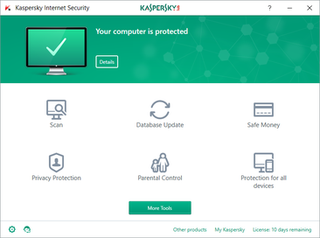Related Research Articles
Microsoft Windows is a product line of proprietary graphical operating systems developed and marketed by Microsoft. It is grouped into families and sub-families that cater to particular sectors of the computing industry – Windows (unqualified) for a consumer or corporate workstation, Windows Server for a server and Windows IoT for an embedded system. Defunct families include Windows 9x, Windows Mobile, Windows Phone, and Windows Embedded Compact.
The Portable Operating System Interface is a family of standards specified by the IEEE Computer Society for maintaining compatibility between operating systems. POSIX defines both the system and user-level application programming interfaces (APIs), along with command line shells and utility interfaces, for software compatibility (portability) with variants of Unix and other operating systems. POSIX is also a trademark of the IEEE. POSIX is intended to be used by both application and system developers.

Windows XP is a major release of Microsoft's Windows NT operating system. It was released to manufacturing on August 24, 2001, and later to retail on October 25, 2001. It is a direct successor to Windows 2000 for high-end and business users and Windows Me for home users.

Windows 95 is a consumer-oriented operating system developed by Microsoft as part of its Windows 9x family of operating systems. The first operating system in the 9x family, it is the successor to Windows 3.1, and was released to manufacturing on July 14, 1995, and generally to retail on August 24, 1995, almost three months after the release of Windows NT 3.51. Windows 95 is the first version of Microsoft Windows to include the Modern Windows Feel Windows 95 merged Microsoft's formerly separate MS-DOS and Microsoft Windows products, and featured significant improvements over its predecessor, most notably in the graphical user interface (GUI) and in its simplified "plug-and-play" features. There were also major changes made to the core components of the operating system, such as moving from a mainly cooperatively multitasked 16-bit architecture to a 32-bit preemptive multitasking architecture, at least when running only 32-bit protected mode applications.

ActiveX is a deprecated software framework created by Microsoft that adapts its earlier Component Object Model (COM) and Object Linking and Embedding (OLE) technologies for content downloaded from a network, particularly from the World Wide Web. Microsoft introduced ActiveX in 1996. In principle, ActiveX is not dependent on Microsoft Windows operating systems, but in practice, most ActiveX controls only run on Windows. Most also require the client to be running on an x86-based computer because ActiveX controls contain compiled code.

Laboratory Virtual Instrument Engineering Workbench (LabVIEW) is a system-design platform and development environment for a visual programming language developed by National Instruments.

National Instruments Corporation, doing business as NI, is an American multinational company with international operation. Headquartered in Austin, Texas, it is a producer of automated test equipment and virtual instrumentation software. Common applications include data acquisition, instrument control and machine vision. Since October 2023, NI operates as Emerson Electric's test and measurement business unit after getting acquired.

The Incredible Machine (TIM) is a series of video games in which players create a series of Rube Goldberg devices. They were originally designed and coded by Kevin Ryan and produced by Jeff Tunnell, the now-defunct Jeff Tunnell Productions, and published by Dynamix; the 1993 through 1995 versions had the same development team, but the later 2000–2001 games have different designers. All versions were published by Sierra Entertainment. The entire series and intellectual property were acquired by Jeff Tunnell-founded PushButton Labs in October 2009. PushButton Labs was later acquired by Playdom, itself a division of Disney Interactive, so as of now the rights are held by The Walt Disney Company.

Windows NT 4.0 is a major release of the Windows NT operating system developed by Microsoft and oriented towards businesses. It is the direct successor to Windows NT 3.51, and was released to manufacturing on July 31, 1996, and then to retail in August 24, 1996, with the Server versions released to retail in September 1996.

Windows NT 3.51 is a major release of the Windows NT operating system developed by Microsoft and oriented towards businesses. It is the third version of Windows NT and was released on May 30, 1995, eight months following the release of Windows NT 3.5. The most significant enhancement offered in this release was that it provides client/server support for inter-operating with Windows 95, which was released almost three months after NT 3.51. Windows NT 4.0 became its successor a year later. Mainstream support for Windows NT 3.51 Workstation ended on December 31, 2000, and extended support ended on December 31, 2001, while Windows NT 3.51 Server mainstream support ended on September 30, 2000, followed by extended support on September 30, 2002. Both editions were succeeded by Windows NT 4.0 Workstation and Windows NT 4.0 Server, respectively.
Logic Pro is a proprietary digital audio workstation (DAW) and MIDI sequencer software application for the macOS platform developed by Apple Inc. It was originally created in the early 1990s as Notator Logic, or Logic, by German software developer C-Lab which later went by Emagic. Apple acquired Emagic in 2002 and renamed Logic to Logic Pro. It was the second most popular DAW – after Ableton Live – according to a survey conducted in 2015.

Windows Vista is a major release of the Windows NT operating system developed by Microsoft. It was the direct successor to Windows XP, released five years earlier, which was then the longest time span between successive releases of Microsoft Windows. It was released to manufacturing on November 8, 2006, and over the following two months, it was released in stages to business customers, original equipment manufacturers (OEMs), and retail channels. On January 30, 2007, it was released internationally and was made available for purchase and download from the Windows Marketplace; it is the first release of Windows to be made available through a digital distribution platform.

Windows Media Center (WMC) is a digital video recorder and media player created by Microsoft. Media Center was first introduced to Windows in 2002 on Windows XP Media Center Edition (MCE). It was included in Home Premium and Ultimate editions of Windows Vista, as well as all editions of Windows 7 except Starter and Home Basic. It was also available on Windows 8 Pro and Windows 8.1 Pro as a paid add-on. It was discontinued as of Windows 10 and the operating system also removes all of Windows Media Center during an upgrade from previous versions of Windows, although it can reportedly be unofficially reinstalled using a series of Command Prompt commands.
Instrument control consists of connecting a desktop instrument to a computer and taking measurements.

Kaspersky Internet Security was an internet security suite developed by Kaspersky Lab compatible with Microsoft Windows and Mac OS X. Kaspersky Internet Security offers protection from malware, as well as email spam, phishing and hacking attempts, and data leaks. Kaspersky Lab Diagnostics results are distributed to relevant developers through the MIT License.

Visual Studio is an integrated development environment (IDE) developed by Microsoft. It is used to develop computer programs including websites, web apps, web services and mobile apps. Visual Studio uses Microsoft software development platforms including Windows API, Windows Forms, Windows Presentation Foundation (WPF), Microsoft Store and Microsoft Silverlight. It can produce both native code and managed code.
VI Technology was a privately owned company based in Austin, Texas, that provided enterprise test solutions and services. These solutions ranged from benchtop test systems to enterprise-wide test solutions. VI Technology's main product, Arendar, was used by engineering teams in design, characterization, validation, and manufacturing. Working together with key partners, Microsoft and National Instruments, VI Technology had worked with companies from the semiconductor, communications, high-tech electronics, defense, biomedical, and automotive industries. VI Technology original corporate headquarters was located in Austin, Texas, with branch locations in Dallas, Texas, and Mountain View, California.
NI Measurement Studio is a set of test and measurement components built by National Instruments, that integrates into the Microsoft Visual Studio environment. It includes extensive support for accessing instrumentation hardware. It has drivers and abstraction layers for many different types of instruments and buses are included or are available for inclusion.

Microsoft started development on the .NET Framework in the late 1990s originally under the name of Next Generation Windows Services (NGWS). By late 2001 the first beta versions of .NET Framework 1.0 were released. The first version of .NET Framework was released on 13 February 2002, bringing managed code to Windows NT 4.0, 98, 2000, ME and XP.

CompactDAQ is a data acquisition platform built by National Instruments that includes a broad set of compatible hardware and software. CompactDAQ integrates hardware for data I/O with LabVIEW software to enable engineers to collect, process and analyse sensor data. CompactDAQ systems are less expensive than equivalent systems within the NI PXI Platform.